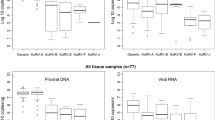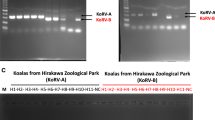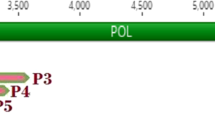Abstract
Koala retrovirus (KoRV), a major pathogen of koalas, exists in both endogenous (KoRV-A) and exogenous forms (KoRV-B to J). However, the impact of infection with multiple subtypes is not well understood. Accordingly, in this study, we surveyed a representative sample from a Japanese zoo population to determine the infection status for three KoRV subtypes (KoRV-A, B, and C) and to investigate the proviral and RNA load profiles in animals with single- and multiple-subtype infections, using peripheral blood mononuclear cells (PBMCs) and plasma. Six koalas were evaluated in the study; all were infected with KoRV-A, and two koalas were coinfected with non-A subtypes (KoRV-B and/or KoRV-C). The highest KoRV total RNA and viral loads in PBMCs and plasma were found in a koala infected with multiple subtypes (KoRV-A, -B and -C). The other koala infected with multiple subtypes (KoRV-A and B) showed the highest proviral PBMC load but the lowest RNA copy number in PBMC and plasma. PBMCs from this animal were cultured for further investigation, and KoRV RNA was detected in the cells and culture supernatant after 7 and/or 14 days. The koalas harboring multiple subtypes had a higher white blood cell count than those harboring only KoRV-A and were judged to be leukemic, and they subsequently died due to lymphoma. Accordingly, we conclude that coinfection with multiple KoRV subtypes may be linked to more-severe disease. In a sequence alignment, the detected KoRV-A env gene showed 100% sequence identity to the reference gene, whereas the KoRV-B and -C env genes varied from their reference sequences.





Similar content being viewed by others
References
Kayesh MEH, Hashem MA, Kohara TK (2020) Koala retrovirus epidemiology, transmission mode, pathogenesis, and host immune response in koalas (Phascolarctos cinereus): a review. Arch Virol 165:2409–2417
Quigley BL, Timms P (2020) Helping koalas battle disease – Recent advances in Chlamydia and koala retrovirus 382 (KoRV) disease understanding and treatment in koalas. FEMS Microbiol Rev 44:583–605
Zheng H, Pan Y, Tang S, Pye GW, Stadler CK, Vogelnest L, Herrin KV, Rideout BA, Switzer WM (2020) Koala retrovirus diversity, transmissibility, and disease associations. Retrovirology 17:34
Hanger JJ, Bromham LD, McKee JJ, O’Brien TM, Robinson WF (2000) The nucleotide sequence of Koala (Phascolarctos cinereus) retrovirus: a novel type C endogenous virus related to Gibbon ape leukemia virus. J Virol 74:4264–4272
Denner J, Young PR (2013) Koala retroviruses: characterization and impact on the life of koalas. Retrovirology 10:108
Simmons G, Clarke D, McKee J, Young P, Meers J (2014) Discovery of a novel retrovirus sequence in an Australian native rodent (Melomys burtoni): a putative link between gibbon ape leukemia virus and koala retrovirus. PLoS ONE 9:e106954
Ishida Y, Zhao K, Greenwood AD, Roca AL (2015) Proliferation of endogenous retroviruses in the early stages of a host germ line invasion. Mol Biol Evol 32:109–120
Hashem MA, Kayesh MEH, Yamato O, Maetani F, Eiei T, Mochizuki K, Sakurai H, Ito A, Kannno H, Kohara KT et al (2019) Coinfection with koala retrovirus subtypes A and B and its impact on captive koalas in Japanese zoos. Arch Virol 164:2735–2745
Tarlinton R, Meers J, Hanger J, Young P (2005) Real-time reverse transcriptase PCR for the endogenous koala retrovirus reveals an association between plasma viral load and neoplastic disease in koalas. J Gen Virol 86:783–787
Xu W, Stadler CK, Gorman K, Jensen N, Kim D, Zheng HQ, Tang S, Switzer WM, Pye GW, Eiden MV (2013) An exogenous retrovirus isolated from koalas with malignant neoplasias in a US zoo. Proc Natl Acad Sci USA 110:11547–11552
Waugh CA, Hanger J, Loader J, King A, Hobbs M, Johnson R, Timms P (2017) Infection with koala retrovirus subgroup B (KoRV-B), but not KoRV-A, is associated with chlamydial disease in free-ranging koalas (Phascolarctos cinereus). Sci Rep 7:134
Fabijan J, Woolford L, Lathe S, Simmons G, Hemmatzadeh F, Trott DJ, Speight KN (2017) Lymphoma, koala retrovirus infection and reproductive chlamydiosis in a koala (Phascolarctos cinereus). J Comp Pathol 157:188–192
Kayesh MEH, Hashem MA, Maetani F, Eiei T, Mochizuki K, Ochiai S, Ito A, Ito N, Sakurai H, Asai T, Kohara KT (2020) CD4, CD8b, and cytokines expression profiles in peripheral blood mononuclear cells infected with different subtypes of KoRV from Koalas (Phascolarctos cinereus) in a Japanese Zoo. Viruses 12:1415
Tarlinton RE, Meers J, Young PR (2006) Retroviral invasion of the koala genome. Nature 442:79–81
Miyazawa T, Shojima T, Yoshikawa R, Ohata T (2011) Isolation of koala retroviruses from koalas in Japan. J Vet Med Sci 73:65–70
Kayesh MEH, Yamato O, Rahman MM, Hashem MA, Maetani F, Eiei T, Mochizuki K, Sakurai H, Kohara KT (2019) Molecular dynamics of koala retrovirus infection in captive koalas in Japan. Arch Virol 164:757–765
Hashem MA, Maetani F, Kayesh MEH, Eiei T, Mochizuki K, Ito A, Sakurai H, Asai T, Kohara KT (2020) Transmission of koala retrovirus from parent koalas to a joey in a Japanese zoo. J Virol 94:e00019–e00020
Kumar SG, Stecher K, Tamura MEGA7 (2016) Molecular evolutionary genetics analysis version 7.0 for bigger datasets. Mol Biol Evol 33:1870–1874
Piatek M, Saag MS, Yang LC, Clark SJ, Kappes JC, Luk KC, Hahn BH, Shaw GM, Lifson JD (1993) High levels of HIV-1 in plasma during all stages of infection determined by competitive PCR. Science 259:1749–1754
Diehl LJ, Mathiason-Dubard CK, O’Neil LL, Hoover EA (1996) Plasma viral RNA load predicts disease progression in accelerated feline immunodeficiency virus infection. J Virol 70:2503–2507
Xu W, Gorman K, Santiago JC, Kluska K, Eiden MV (2015) Genetic diversity of koala retroviral envelopes. Viruses 7:1258–1270
Quigley BL, Ong VA, Hanger J, Timms P (2018) Molecular dynamics and mode of transmission of koala retrovirus as it invades and spreads through a wild Queensland koala population. J Virol 92:e01871-e1917
Quigley BL, Phillips S, Olagoke O, Robbins A, Hanger J, Timms P (2019) Changes in endogenous and exogenous koala retrovirus subtype expression over time reflect koala health outcomes. J Virol 93:18
Sarker N, Fabijan J, Seddon J, Tarlinton R, Owen H, Simmons G, Thia J, Blanchard AM, Speight N, Kaler J et al (2019) Genetic diversity of Koala retrovirus env gene subtypes: insights into northern and southern koala populations. J Gen Virol 100:1328–1339
Acknowledgements
We would like to thank Henry Smith of the Joint Faculty of Veterinary Medicine, Kagoshima University, Japan, for his enthusiastic English edition of this manuscript.
Funding
This study was supported by the Ministry of Education, Culture, Sports, Science and Technology, Japan.
Author information
Authors and Affiliations
Contributions
Conceptualization: MAH and KT-K; conducting of experiments: MAH, MEHK, FM, TE, KM, SO, AI, NI, HS, TA and KT-K; data analysis: MAH and KT-K; original draft preparation: MAH and KT-K; reviewing and editing, MAH, MEHK and KT-K; supervision: KT-K. All authors have read and agreed to the published version of the manuscript.
Corresponding author
Ethics declarations
Conflict of interest
The authors declare that they have no competing interest.
Ethical approval
This study was performed in accordance with the protocols of the Institutional Animal Care and Use Committee of the Joint Faculty of Veterinary Medicine, Kagoshima University, Japan.
Additional information
Handling Editor: William G. Dundon.
Publisher's Note
Springer Nature remains neutral with regard to jurisdictional claims in published maps and institutional affiliations.
Rights and permissions
About this article
Cite this article
Hashem, M.A., Kayesh, M.E.H., Maetani, F. et al. Koala retrovirus (KoRV) subtypes and their impact on captive koala (Phascolarctos cinereus) health. Arch Virol 166, 1893–1901 (2021). https://doi.org/10.1007/s00705-021-05078-y
Received:
Accepted:
Published:
Issue Date:
DOI: https://doi.org/10.1007/s00705-021-05078-y




